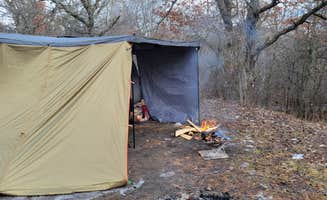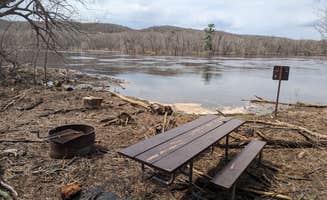Rustic camping near Anoka, Minnesota offers free dispersed sites nestled within the region's distinctive combination of pine forests and sandy terrain. The area sits at approximately 900 feet above sea level and experiences seasonal extremes with summer temperatures averaging 75-85°F and winter temperatures often dropping below freezing. Fall camping provides colorful foliage displays while spring brings abundant wildlife activity to these primitive sites.
What to do
Birdwatching expeditions: The diverse habitats surrounding South of Sand Dunes State Forest attract numerous bird species. "Quiet with lots of different bird sounds," notes Jason B., who recommends early morning observations when activity peaks.
Trail exploration: Multiple unmarked paths branch from main access roads, creating opportunities for solitary hiking. "I was able to walk in and find an incredible spot to camp and lay in my hammock," shares Joslyn H., highlighting the accessible nature of these primitive trails.
River activities: Paddling options exist at County Road O Landing Dispersed River Camp, where the St. Croix River provides recreational opportunities. "Pretty campsite with boat ramp to St Croix river," reports Aly E., making it suitable for canoes and small watercraft.
What campers like
Natural seclusion: The relative isolation appeals to those seeking quiet wilderness experiences. "There's lots of little spots off the main gravel road. Nothing allowed further into the forest. One pull through area that I found. Couple vehicles pass a day," explains Heather W. about her experience at Sand Dunes State Forest.
Proximity to urban areas: Location convenience remains a significant advantage for weekend getaways. "I love that it's so close to home," writes Joslyn H., appreciating the accessibility from nearby metropolitan areas.
Wildlife encounters: Native animals frequently visit these rustic camping sites. "Stand storks are very protective. Stay away from them. They attack," warns Heather W., highlighting the authentic nature experiences available in these areas.
What you should know
Limited facilities: Most dispersed camping options provide minimal or no infrastructure. At Sandy Cove on the St. Croix River, "There is a pad at the bottom of the path up to the open air vault toilet, a fire ring, and a table. The table has an extra long side for those in a wheelchair," explains Travis B., describing one of the rare sites with basic amenities.
Seasonal challenges: Weather conditions significantly impact access and comfort. "We camped here on our way to the badlands starting from michigan. It was easy to find, and the spot itself was good and had restrooms. The only problem was the mosquitoes," reports Marie G. about her June camping experience.
Vehicle considerations: Road conditions vary throughout the area. "Great spot. Plenty of parking. Best for straight vehicles or very small trailers," advises Skip H., noting size limitations at many primitive sites.
Tips for camping with families
Location selection: Choose sites with adequate space for multiple tents and activities. "For the proximity to the city and nearby highways, this was a good spot. Didn't expect to see as many campers as I did, but all seemed to be friendly," mentions Samuel C., suggesting positioning near main access points for increased safety.
Safety precautions: Prepare for wildlife encounters and limited communication. "I parked near the front and closer to numbers, always like to be safer," Samuel C. recommends, prioritizing visibility and accessibility.
Timing considerations: Weekday visits typically provide quieter experiences. "Came back on a warm weekend. A bit more traffic, but after 12 p.m., not much of anything," reports Skip H., noting traffic patterns at South of Sand Dunes State Forest.
Tips from RVers
Size restrictions: Most dispersed camping near Anoka accommodates smaller recreational vehicles only. "I just did an overnight camp one night in a truck camper and it was very easy to navigate and it was cleaned quiet area to spend the night," shares Adam W., confirming the suitability for compact units.
Accessibility challenges: Several access roads present difficulties for larger setups. "Drove past several sites, most of which were by water. We did find one we thought we liked, but branches over hung, and rested on our camper (8ft high) and in fact most sites were shaded," Gregory explains, highlighting clearance issues even with medium-height vehicles.
Regulatory awareness: Local enforcement affects camping options for certain vehicles. "Be aware if you have an rv though. I had a county sheriff person tell me it's not lawful to park a trailer and they kicked me out. I called the dnr and they said that wasn't right but I decided to leave anyway," warns Jason B., indicating inconsistent rule interpretation by different authorities.



